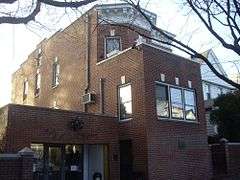Louis Armstrong House
|
Louis Armstrong House | |
|
Louis Armstrong House, December 2007 | |
   | |
| Location | Queens, New York |
|---|---|
| Coordinates | 40°45′20″N 73°51′43″W / 40.75556°N 73.86194°WCoordinates: 40°45′20″N 73°51′43″W / 40.75556°N 73.86194°W |
| Built | 1910[1] |
| Architect | Robert W. Johnson[1] |
| NRHP Reference # | 76001265 |
| Significant dates | |
| Added to NRHP | May 11, 1976[2] |
| Designated NHL | May 11, 1976[3] |
| Designated NYCL | December 13, 1988 |
The Louis Armstrong House was the home of Louis Armstrong and his wife Lucille Wilson from 1943 until his death in 1971. Lucille gave ownership of it to the city of New York in order to create a museum focused on her husband. It was designated a New York City Landmark in 1988[1] and declared a National Historic Landmark in 1976.
It is located at 34-56 107th Street near 37th Avenue, in Corona, Queens, New York City.[3][4] The house is now a museum that presents concerts and educational programs, operates as a historic house museum and makes materials in its archives of writings, books, recordings and memorabilia available to the public for research.
Background
The Louis Armstrong Educational Foundation gave the house to the Department of Culture Affairs after Lucille Armstrong passed away in 1983. This brick house was designed by architect Robert W. Johnson and built by Thomas Daly in 1910.[5] Some changes were made to the exterior and interior of the house when the Armstrongs moved in. The porch that was once in the front of the house was taken down and the space was added to the living room. For the exterior of the house the garden was assembled and the garage was constructed by the Armstrong's.[6]
In addition the interior of the house was renovated to their taste.[7] Ornate bathrooms, and the kitchen was not originally part of the house. Paintings and souvenirs were given to Louis Armstrong on tour from Asia, Europe to Africa. These gifts have found a home of their own on dressers, night stands, shelves and walls.
Cultural Influence
Throughout Louis Armstrong's life he had joined and created musical groups until he started playing solo. Jazz was played in the arrangement of an orchestra, or ensemble where no one had a longer solo than the other. Armstrong was versatile in using different techniques in jazz to the extent that he shaped many musicians from his time till this day.[8] His swing and scat singing not only became popular around the world, but changed the way music was danced as well.
Political Significance
Racism was a problem that everyone knew the U.S had, and the government would send African American artists, athletes and musicians to other countries in order to challenge this belief. When Armstrong found out about the Little Rock Nine incident where nine black students were blocked and prevented from entering an all-white school he spoke up. Moved by anger Armstrong refused to play in the Soviet Union, and as a result increased the amount of activities in the civil rights movement. Furthermore, he insulted President Eisenhower.[9] While Armstrong played an important role in 20th century cultural music by performing around the world, he was also a significant political figure who had America think twice about racism.[10]
See also
References
- 1 2 3 Dolkart, Andrew S. & Postal, Matthew A.; Guide to New York City Landmarks, 3rd Edition; New York City Landmarks Preservation Commission; John Wiley & Sons, Inc. 2004. ISBN 0-471-36900-4; p.283.
- ↑ National Park Service (2007-01-23). "National Register Information System". National Register of Historic Places. National Park Service.
- 1 2 "Louis Armstrong House". National Historic Landmark summary listing. National Park Service. 2007-09-15.
- ↑ Lynne Gomez Graves (February 3, 1976). "National Register of Historic Places Inventory-Nomination: Louis Armstrong House" (pdf). National Park Service. and Accompanying photos, exterior, from 1976 (1.36 MB)
- ↑ http://www.louisarmstronghouse.org/about/history.htm
- ↑ http://www2.cuny.edu/wp-content/uploads/sites/4/2015/01/QueensCollege_HistoricLandmark.pdf
- ↑ http://articles.baltimoresun.com/2003-11-02/news/0311020215_1_louis-armstrong-jazz-american-music
- ↑ http://www.pbs.org/wnet/americanmasters/louis-armstrong-about-louis-armstrong/528/
- ↑ http://www.history.com/this-day-in-history/louis-armstrong-cancels-trip-to-russia
- ↑ http://www.larmstrongsoc.org/history-of-louis-armstrong/
External links
![]() Media related to Louis Armstrong House at Wikimedia Commons
Media related to Louis Armstrong House at Wikimedia Commons


